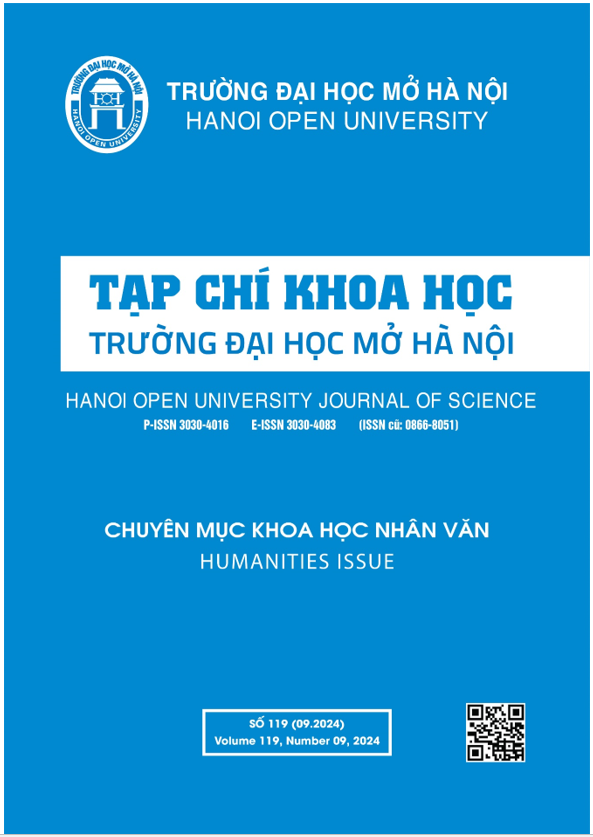AN EVALUATION OF THE TEACHING-LEARNING CONTENTS IN THE TEXTBOOK “ACTIVE SKILLS FOR READING 4” FROM THE PERSPECTIVES OF LECTURERS AND STUDENTS AT THE FACULTY OF ENGLISH, HANOI OPEN UNIVERSITY
DOI:
https://doi.org/10.59266/houjs.2024.463Từ khóa:
textbook evaluation, exercises, tasks, Active skills for reading 4, course learning outcomesTóm tắt
This study was conducted to find out the opinions of lecturers and students about the teaching-learning contents in the textbook "Active Skills for Reading 4" used to teach Reading Skills level 6 to third-year students majoring in English at Hanoi Open University. The author used a mixed research method, combining quantitative and qualitative research methods to analyze data. The list of textbook evaluation checklists compiled by Litz (2005) and the authors Mukundan, Nimehchisalem, and Hajimohammadi (2011), after being edited to suit the research object, is used as the main research tool. Eight lecturers and eighty-four third-year students majoring in English at Hanoi Open University participated in the study, and two teachers were invited to participate in interviews to clarify some information. The data collected revealed that most surveyed lecturers and students highly appreciated the diversity of topics, their interest in reading comprehension, and the clarity of instructions for the exercises in the textbook Active Skills for Reading 4. However, the criteria for the diversity of question types, quantity and variety of vocabulary, and way of introducing vocabulary are not highly appreciated. Based on the findings, the interviewed lecturers made some recommendations on how to use this textbook more effectively. The study has helpful theoretical and practical contributions to textbook selection, evaluation, and effective use of textbooks.
Tài liệu tham khảo
[1]. Ahour, T., & Ahmadi, E. (2012). Retrospective evaluation of textbook “Summit 2B” for its suitability for EFL undergraduate students. Book of Proceedings of the International Conference on Human and Social Sciences, pp. 176-184.
[2]. Ahmadi and Derakhshan (2016). EFL Teachers’ Perceptions Towards Textbook Evaluation. Theory and Practice in Language Studies, Vol. 6, No. 2, pp. 260-267. DOI: http://dx.doi. org/10.17507/tpls.0602.06
[3]. Beeby, C. E., (1977). The Meaning of Evaluation, Current Issues in Education, 4.
[4]. Branch, RM (2009). Instructional Design - The ADDIE Approach. New York: Springer
[5]. Council of Europe (2020). Common European Framework of Reference for Languages: Learning, Teaching, Assessment—Companion Volume. Council of Europe Publishing.
[6]. Creswell, J. W. & Clark, V. L. P., (2011). Designing and Conducting Mixed Methods Research. (2nd ed). London: Sage Publications.
[7]. Cunningsworth, A. (1984). Evaluating and Selecting EFL Teaching Materials. London: Heinemann.
[8]. Cunningsworth, A. (1995). Choosing Your Coursebook. Oxford: Heinemann.
[9]. Ellis, R., (1997). The empirical evaluation of language teaching materials. ELT Journal, 51(1), 36-42.
[10]. Hutchinson, T., & Torres, E. (1994). The textbook as an agent of change. ELT Journal, 48(4), 315-328. https:// doi.org/10.1093/elt/48.4.315
[11]. Littlejohn, A. (1998). The analysis of Language teaching materials: Inside the Trojan horse. In Tomlinson, B. (Ed.), Materials Development in Language Teaching (pp. 190-216). Cambridge: Cambridge University Press.
[12]. Litz, D. R. A. (2005). Textbook evaluation and ELT management: A South Korean case study. The Asian EFL Journal, 48(1), 1-53. https://www. asian-efl-journal.com/Litz_thesis.pdf
[13]. Mc Donough & Shaw, C. (1993). Materials and Methods in ELT: A Teacher’s Guide, Blackwell.
[14]. Miekley, J. (2005). ESL textbook evaluation checklist. The Reading Matrix, 5(2).
[15]. Mukundan at al. (2011). Developing an English language textbook evaluation checklist: a focus group study. International Journal of Humanities and Social Science, 1(12), 100-106.
[16]. McGrath, I. (2002). Materials evaluation and design for language teaching. Edinburgh: Edinburgh University Press.
[17]. Neil J. Anderson (2014). Active Skills for Reading 4. (3rd edition). CENGAGE Learning.
[18]. Sabzalipour, B., & Koosha, M. (2014). The evaluation of Iranian high school English textbooks from the perspective of teachers. Asian Journal of Social Sciences and Humanities, 3(3), 215-228.
[19]. Soori, A., & Jamshidi, T. (2013). Textbook evaluation for the students of speech therapy. Advances in Language and Literary Studies, 4(2), 159-164.
[20]. Tomlinson,B.(2003).Materialsevaluation. In B. Tomlinson (Ed.), Developing Materials for Language Teaching (pp. 15- 36). London: Continuum.
[21]. Tomlinson, B. (2011). Materials development in language teaching (2nd edition.). Cambridge: Cambridge University Press.
[22]. Ur, P. (1996). A course in language teaching. Cambridge: Cambridge University Press.
